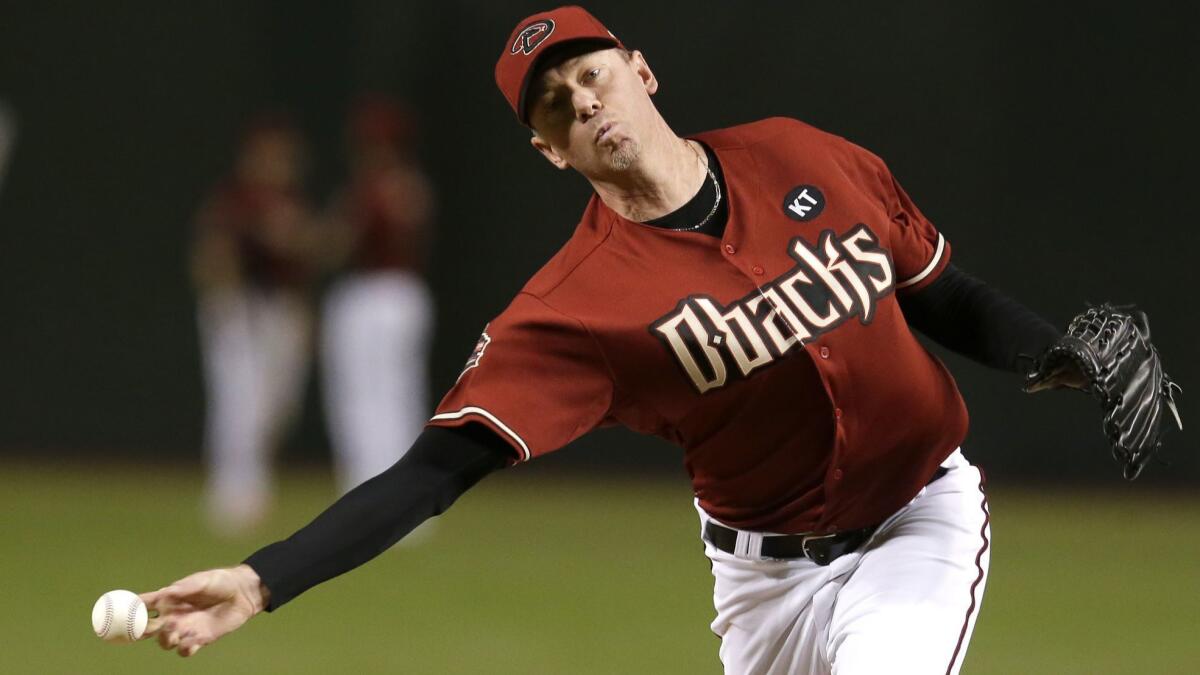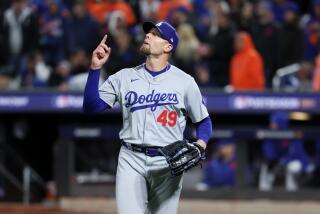Column: Dodgers could learn a thing or two from Diamondbacks’ bullpen
It was a pretty good time to be Brad Ziegler, or at least it should have been.
The veteran reliever had put up a 2.25 earned-run average in 2016, the fifth time in six years he finished below 2.50. He had pitched nine years in the major leagues and never had been on the disabled list.
He was a free agent, so he thought he would use his leverage to sign with a team in the Midwest. He lives in Kansas City, and he wanted to make life easier on his kids.
“There were teams that just didn’t have an interest, flat out,” Ziegler said. “It didn’t matter what kind of discount I might have been willing to take to stay close to home. It was just, ‘Sorry, it doesn’t matter what you’re willing to do, we’re not interested.’ ”
There was one line on his scouting report that scared most teams: Fastball, 84 mph.
He got outs, two-thirds of them on ground balls, with an unorthodox delivery and an effective changeup. But, in this era when velocity is worshiped above all else, Ziegler was an outcast to many teams.
Don’t cry for him. He had to go to Miami to get paid, but he did, $16 million for two seasons. In July, with two months remaining on the contract, the Marlins traded him to Arizona.He hasn’t pitched as well since he signed the contract, but the first-place Diamondbacks still added him to the best bullpen in the National League.
In this day and age, this juxtaposition might be particularly jarring: Entering Saturday, the Diamondbacks had the lowest earned-run average of any bullpen in the league, and the fewest strikeouts of any bullpen in the league.
In 2016 and 2017, the Dodgers’ bullpen had the lowest ERA in the league and the most strikeouts.
As the calendar turns to September, the NL West has turned into a three-team death match. One of the combatants, the Colorado Rockies, spent $106 million on relievers last winter. The Dodgers spent $2 million, on a guy who got hurt and did not throw a pitch this season.
The Diamondbacks lead them both, and they did it their way. They got their closer, Brad Boxberger, in a trade with Tampa Bay, for a minor leaguer. They got a setup man, Yoshihisa Hirano from Japan, at a time most of the baseball world was obsessed with Shohei Ohtani.
Archie Bradley and Andrew Chafin are first-round draft picks, power arms converted to relievers. T.J. McFarland has a 1.82 ERA, a below-average fastball, and gets two-thirds of his outs on ground balls. Jake Diekman, a left-hander with an above-average fastball, was acquired from Texas for two low-level minor leaguers at the July trade deadline.
“The biggest thing, I think, is that we have a lot of variety in this ’pen,” Ziegler said. “I’ve seen bullpens where every right-handed pitcher throws 94 to 97. They’re all kind of the same guy.
“Here, we have three lefties, we have four righties, and they all come from different angles, and they have different styles. I think it’s difficult for teams to adjust to.”
Mike Hazen, the Diamondbacks’ general manager, declined to comment on how he assembled his bullpen.
Nonetheless, two factors stand out. First, the Diamondbacks field what is arguably the best defense in baseball. They lead the majors in defensive runs saved, and only one other team has saved even half as many runs.
If you’re going to trust ground-ball pitchers, you’d better trust the fielders needed to convert those ground balls into outs.
“We have a great defense, and we’re not afraid to use it,” Ziegler said.
Arizona reliever Archie Bradley added: “Strikeouts are cool, and sometimes they’re needed, but with the way we play defense, we really delve into our scouting reports, and where to throw pitches, and what results we get from those pitches. It’s been huge for us.”

Second, the Diamondbacks’ starters led the league in innings pitched entering Saturday. The Diamondbacks can match up individual batters with individual relievers in the seventh and eighth innings, because they have not exhausted their bullpen just to get there.
“It makes our job a whole lot easier,” Ziegler said, “because we don’t have to cover four or five innings every night.”
The Rockies’ starters ranked third in the league in innings pitched. The Dodgers’ starters ranked 10th.
Mike Butcher, the Diamondbacks’ pitching coach, attributed the explosion in velocity among relief pitchers in part to a shift in how teams manage their personnel.
The long reliever is an endangered species, he said, particularly in the NL. No longer do teams throw a guy for a few innings just to give the rest of the bullpen a break. They throw a few arms in shorter stints and, rather than rest them for a couple days, they shuttle them to the minor leagues and replace them with fresh arms.
The fewer pitches you have to throw, the harder you can throw them. Run out of fresh arms for a day, and there is no longer any shame in using a position player for an inning, or three.
“Most bullpens in the big leagues right now typically have one-inning guys in the back of the bullpen, whether it’s the sixth, seventh, eighth or ninth inning,” Butcher said.
He would not say that the Diamondbacks have unlocked a secret to relief success by reversing the rush toward maximum velocity for every bullpen arm. The Dodgers even expressed interest in Ziegler when he was a free agent, although Ziegler said they did not offer him a contract and became much less interested after they re-signed Kenley Jansen.
“I don’t know that we’re necessarily a trendsetter by any means,” Butcher said. “There’s a lot of different ways to look at a bullpen these days, with all of the metrics that are out there. They may take risks on some guys. Velocity is definitely not the only thing out there to measure with, or spin rate, or anything else. You try to get guys that can execute pitches and get people out.
“Look across the game, and you see some power arms out there. You don’t shy away from those guys. The Dodgers have some really nice arms as well. You never know. You look at all the bullpens. It can be very volatile at times. That’s just the nature of the game.”
Frankly, Bradley said, the Arizona relievers could not care less how they get their outs, strikeout or otherwise, so long as they get them.
“We just want to win,” he said. “Really, we want to be the bullpen that doesn’t get blamed for losing games. There’s a lot of stuff that happens before the bullpen goes into action that can determine a game.
“But, if the bullpen blows a game, that’s the only thing that people remember.”
To that, Dodgers fans can offer a four-letter response: Amen.
Follow Bill Shaikin on Twitter @BillShaikin
More to Read
Go beyond the scoreboard
Get the latest on L.A.'s teams in the daily Sports Report newsletter.
You may occasionally receive promotional content from the Los Angeles Times.











